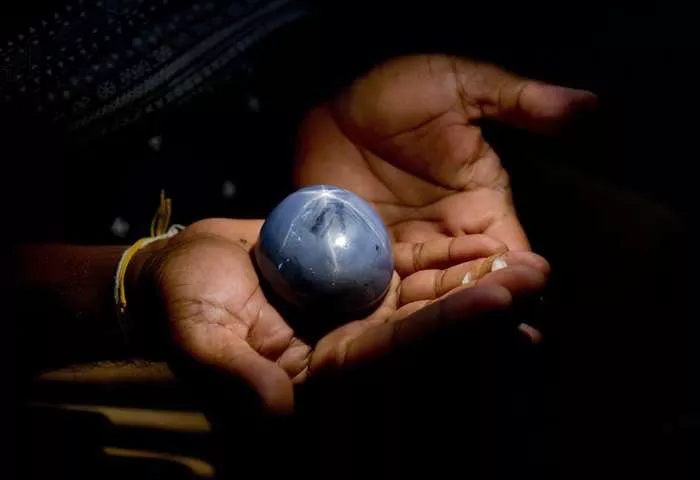The Star of Adam sapphire is one of the most famous and valuable blue sapphires in the world. It is known for its incredible size, rare color, and stunning star effect. This gemstone has a fascinating history and is highly sought after by collectors and jewelry enthusiasts.
In this article, we will explore what makes the Star of Adam sapphire special, its origin and discovery, physical and optical properties, how it compares to other famous sapphires, its value in the jewelry market, and how to identify a genuine star sapphire. By the end, you will have a deep understanding of this remarkable gemstone.
What is the Star of Adam Sapphire?
The Star of Adam is a blue star sapphire, weighing an astonishing 1,404 carats. It is one of the largest blue star sapphires ever found.
The name “Star of Adam” comes from Islamic tradition, as some believe Adam landed in Sri Lanka after leaving Eden.
The sapphire has a deep blue color with a velvety appearance and displays a six-rayed star that moves with light. It is cut in an oval cabochon shape, meaning it has a smooth, polished surface without facets. The gemstone originates from Sri Lanka, formerly known as Ceylon, which is famous for producing high-quality sapphires.
Discovery and History
The Star of Adam was discovered in 2015 in Ratnapura, Sri Lanka, a region renowned for its gem pits. It was found by a miner and quickly gained recognition as one of the largest star sapphires in existence.
By 2016, it was officially named and valued at over $100 million. Today, its ownership remains private, but its fame continues to grow. Sri Lanka has been a top source of sapphires for over 2,000 years, making the Star of Adam part of a long tradition of exceptional gemstones.
Physical and Optical Properties
Chemical Composition
The Star of Adam is made of corundum, a mineral composed of aluminum oxide. Its deep blue color comes from trace amounts of titanium and iron within the crystal structure. With a hardness of 9 on the Mohs scale, it is extremely durable, second only to diamond.
The Star Effect (Asterism)
The star effect, known as asterism, is caused by tiny needle-like inclusions of rutile. When light hits these inclusions, it reflects in a six-rayed pattern. The Star of Adam has a sharp, well-centered star, which adds to its rarity and value.
Clarity and Transparency
Most star sapphires are translucent rather than fully transparent due to the rutile inclusions. The finest specimens, like the Star of Adam, strike a perfect balance between clarity and a strong, visible star.
How Does It Compare to Other Famous Sapphires?
Star of India
The Star of India weighs 563 carats and has a grayish-blue color. It is also from Sri Lanka and is displayed at the American Museum of Natural History. However, the Star of Adam is significantly larger and has a deeper, more vibrant blue hue.
Black Star of Queensland
This sapphire weighs 733 carats and is black with a silver star. It was mined in Australia. While impressive, it lacks the rich blue color that makes the Star of Adam so desirable.
Logan Sapphire
The Logan Sapphire is a 423-carat deep blue sapphire with no star effect. It is faceted rather than cut as a cabochon. The Star of Adam, with its asterism, offers a completely different kind of beauty.
The Star of Adam stands out due to its size, intense color, and sharp star effect, making it one of the most extraordinary sapphires in existence.
Value and Market Demand
Factors Affecting Value
The Star of Adam’s value comes from its enormous size, deep blue color, and well-defined star. Sapphires from Sri Lanka are highly prized, and those with strong asterism command premium prices.
Estimated Worth
High−qualitystarsapphirescansellfor50,000 to $100,000 per carat, depending on their characteristics.
Potential Buyers
Such rare gemstones are typically purchased by private collectors, museums, and royalty. Most star sapphires over 100 carats are kept in private collections or displayed in museums.
How to Identify a Genuine Star Sapphire
Natural vs. Synthetic
Natural star sapphires have slight imperfections and an uneven star that moves with light. Lab-grown sapphires often look too perfect and lack the depth of natural stones.
Fake Star Sapphires
Some imitations are made of glass or dyed stones. A painted or etched star will not move when tilted, and dyed stones may show uneven color under magnification.
Certification
Always request a gemological certificate from reputable labs such as the Gemological Institute of America (GIA), American Gemological Laboratories (AGL), or Gübelin.
Caring for a Star Sapphire
To maintain its beauty, clean the stone with warm soapy water and a soft brush. Avoid harsh chemicals and store it separately to prevent scratches. Extreme heat should also be avoided, as it can damage the gem.
Conclusion
The Star of Adam sapphire is a masterpiece of nature—rare, beautiful, and full of mystery. Its deep blue color, sharp star effect, and enormous size make it one of the most extraordinary gemstones in history.
Whether you are a collector, jeweler, or gem enthusiast, understanding this sapphire helps appreciate the wonders of the Earth’s natural treasures. Would you like to own a star sapphire one day? Even a small one carries the magic of the stars.
Related Topics:
- What Is the Largest Sapphire in the World?
- What Does a Diamond Look like with a Yellow Sapphire?
- What Are Diamond and Sapphire Rings in Gold?


